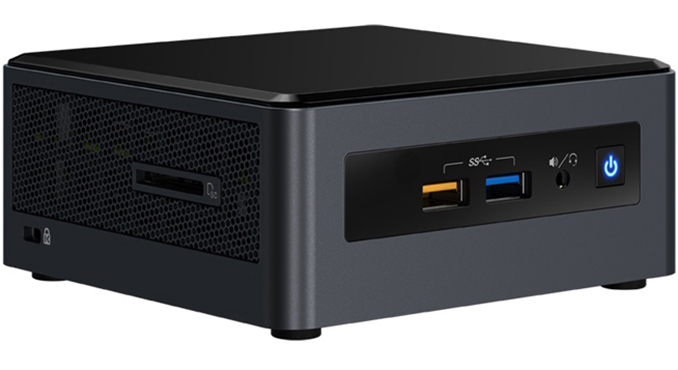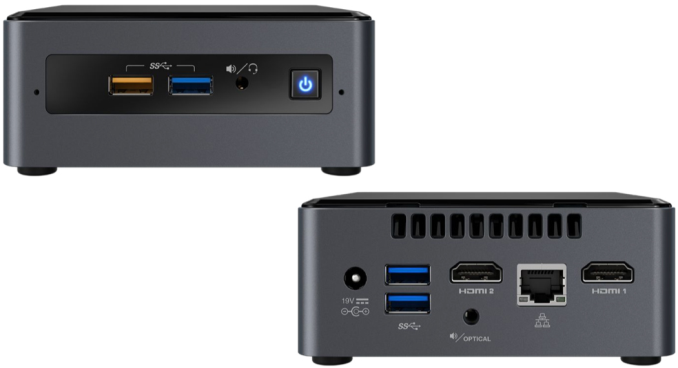More 10nm Cannon Lake: Coming to Intel NUC, Officially
by Anton Shilov on August 16, 2018 8:30 AM EST- Posted in
- Desktop
- Intel
- NUC
- 10nm
- Cannon Lake
- Crimson Canyon
- i3-8121U

Intel late on Wednesday formally introduced its Crimson Canyon NUCs based on its 10nm Cannon Lake processors and equipped with AMD’s standalone Radeon 540 graphics chip. The new NUC8i3CY-series PCs are the first systems of their kind (SFF) to use Intel’s CPU made using its 10 nm process technology as well as a discrete GPU on a separate chip.
A retailer specializing on custom-built Intel’s NUC UCFF PCs disclosed virtually all specifications of Intel’s NUC8i3CYSM and NUC8i3CYSN earlier this month, so we already know most of the details regarding the systems. The new NUCs are powered by Intel’s dual-core Core i3-8121U processor that works in tandem with AMD’s Radeon 540 dGPU (codenamed Lexa, based on Polaris architecture, featuring 512 SPs) with 2 GB of GDDR5 memory. The NUCs are outfitted with soldered-down 4 GB or 8 GB of LPDDR4-2666 memory and come with a 1 TB SATA hard drive. Users that want faster storage can install an M.2-2280 SSD with a SATA or a PCIe interface.
When it comes to wireless connectivity, the NUC8i3CY-series UCFF PCs are equipped with Intel’s Wireless-AC 9560 CNVi 802.11ac Wi-Fi + Bluetooth 5 solution that supports up to 1.73 Gbps throughput over 160 MHz channels. As for physical connectors, the NUCs have one GbE, two HDMI 2.0a outputs, four USB 3.0 Type-A ports (one supporting charging), an SD card reader, a TRRS audio connector for headsets, and a digital audio connector for 7.1-channel sound systems.
The key feature of Intel’s NUC8i3CY-series systems is the Cannon Lake processor made using a 10 nm fabrication technology. The Core i3-8121U chip is clocked at 2.2 GHz base to 3.2 GHz turbo, which is slightly below frequencies of the Core i3-8130U (2.2 – 3.4 GHz) made using Intel’s 14+ manufacturing process. The Cannon Lake CPUs support AVX-512 extensions that can speed up operations with large datasets that are not common on UCFF PCs, so whether or not this technology makes sense for typical owners of NUCs is up to debate. What is noteworthy is that Intel has enough 10-nm CPUs to install them in its own NUCs that tend to be rather popular miniature desktops.
Intel officially positions its NUC8i3CY-series systems as affordable solutions for gamers who play titles like League of Legends, TF2, as well as CS:GO and can therefore take advantage of AMD’s discrete Radeon 540 graphics chip. This dGPU is clearly faster than Intel’s UHD 630 iGPU in games, but Intel’s latest iGPUs have numerous advantages over AMD’s Polaris when it comes to media playback. For example, they featureVP9 10-bit decode, and support sophisticated copyright protection methods that require Intel’s SGX.
| Intel Crimson Canyon NUC PCs | |||
| NUC8i3CYSN | NUC8i3CYSM | ||
| CPU | Intel Core i3-8121U 2C/4T 2.2 - 3.2 GHz 4 MB cache 15 W TDP |
||
| Graphics | AMD Radeon 540 GPU 512 stream processors 32 texture units 16 ROPs 2 GB GDDR5 memory |
||
| PCH | Integrated into CPU | ||
| Memory | 4 GB LPDDR4-2666 | 8 GB LPDDR4-2666 | |
| Storage | 2.5-inch | 1 TB HDD pre-installed | |
| M.2 | M.2-2280 slot, SATA or PCIe SSDs or Intel Optane Memory |
||
| Wi-Fi/BT | Intel Wireless-AC 9560 802.11ac Wi-Fi + BT 5 |
||
| Ethernet | Intel Gigabit Ethernet controller (i219-V) | ||
| Display Outputs | 2 × HDMI 2.0a | ||
| Audio | 3.5 mm TRRS audio jack 7.1 channel audio output via HDMI Optical output |
||
| IR | Consumer Infrared (CIR) sensor on the front panel | ||
| USB | 4 USB 3.0 Type-A (5 Gbps), one with charging | ||
| Other I/O | SDXC card reader with UHS-I support | ||
| Dimensions | 117 × 112 × 52 mm | 4.6 × 4.4 × 2.04 inch | ||
| PSU | External, 90 W | ||
| OS | Pre-installed Microsoft Windows 10 Home x64 | ||
Intel said that its Crimson Canyon NUCs will be available in September, but did not announce their official prices. Previously it was reported that the NUC8i3CY-series systems will cost $530 – $575, but since this information is unofficial, it is always subject to change.
Related Reading
- Intel’s Crimson Canyon NUCs with Cannon Lake CPU & Radeon dGPU Available for Pre-Order
- First 10nm Cannon Lake Laptop Spotted Online: Lenovo Ideapad 330 for $449
- Intel Officially Launches Bean Canyon NUCs with Coffee Lake-U Processors
- The Intel NUC8i7HVK (Hades Canyon) Review: Kaby Lake-G Benchmarked
- Intel NUC8i7HVK (Hades Canyon) Gaming Performance - A Second Look
- Intel NUC6CAYH (Arches Canyon) Apollo Lake UCFF PC Review
Source: Intel











20 Comments
View All Comments
Wilco1 - Thursday, August 16, 2018 - link
An Apple phone outperforms this both single and multithreaded by a good margin. Any serious developer would avoid this like the plague.OFelix - Thursday, August 16, 2018 - link
Dissapointed that it does not have Thunderbolt.Also, won't buy without 512GB SSD and 16GB RAM.
damianrobertjones - Monday, August 20, 2018 - link
What device were you going to add, to the nuc, that would use thunderbolt? Just asking as this is an i3 so hardly mega-powerful.SquarePeg - Thursday, August 16, 2018 - link
This a seriously disappointing piece of hardware. At 10nm I would expect this level of performance to produce something closer to 6 watts of heat and be passively cooled. It really makes me wonder if Intel's 10nm will be the new 20nm planar.Santoval - Sunday, August 19, 2018 - link
Intel's first gen 10nm node appears to be wildly inefficient, on top of providing poor yields*. Either of these is very bad, both are an engineering and financial nightmare. This is why Intel is going to skip its (and Cannon Lake's) high volume release and release 10nm+ Ice Lake CPUs in high volume instead in late 2019.*Having the same base clock and a lower boost clock with an equivalent 14nm+ CPU at the same TDP, while retaining the same architecture (with an added AVX-512 block that is never going to be used), means that Intel saw no power efficiency gain *at all* by moving from 14nm to 10nm, despite the 2 - 2.2 times smaller die, and in fact power efficiency even regressed a little. There are no words to describe adequately how bad and embarrassing this is for Intel.
This CPU is literally an explanation "in the flesh" of Intel's serious problems with their 10nm node and why its release was delayed for so long.
Santoval - Sunday, August 19, 2018 - link
This sole Cannon Lake CPU that Intel released looks and feels and smells like a beta CPU. Its clocks are low because Intel's first gen 10nm process is utter crap, it is unknown how well and how long it will be able to hold that boost clock, and above all, of course, its yields are so poor that Intel had to disable its iGPU.Since Intel will release 10nm+ based Ice Lake CPUs at the end of 2019, not 10nm based Cannon Lake ones, this CPU might turn out be the singular Cannon Lake release, proving that Intel is effectively beta testing its 10nm node after being deployed.
I read that ASML helped Intel overcome their issues with their 10nm node, and now they are testing and validating the fixes. It appears that Intel will apply these fixes to 10nm+, not to 10nm (Cannon Lake was always going to be a stop gap before Ice Lake anyway), so the latter will remain for all intents and purposes a beta node, and thus Cannon Lakes will remain beta CPUs.
eastcoast_pete - Sunday, August 19, 2018 - link
Agree that this first 10 nm Cannon Lake release has a more than a whiff of "early beta" to it. The combination of lower clock speeds than similar 14 nm processors BUT yet with AVX 512 enabled suggests that these are either for developers (although I am not sure I'd like to use NUCs for testing out software) or for those who hope that embedded VEGA graphics will help the NUCs make it to gaming territory.The only reason these NUCs are not completely stillborn is that AMD or its vendors don't have a "NUC-alike" based on 4 core Ryzen plus embedded Vega. Wonder why, there is a market here and money to be made, a 2400G class machine with lowered TDP (or keep the TDP, and add a good thermal design with quiet fans) would sell like hotcakes.
abufrejoval - Monday, August 20, 2018 - link
With all the hinting from Charly my impression is twofold:1. They have tons of wafers with 10nm chips where the iGPU portion has close to 0% yields, but at least the CPUs are functional, if only at voltage/performance levels which preclude mobile use (worse than their 14nm counterparts)
2. They need to "assure" their investors, that 10nm is indeed shipping, while they do not expand on the fact that it's currently shipping crap at low yields overall
So if things were anywhere close to normal, they'd probably convert these chips back into sand. But given the state of the fab, they opt for doing "something special" that anyone visiting this site shouldn't touch with a long pole.
Sifa - Monday, August 20, 2018 - link
As per my observation, these as potential lower cost box for developers and web developers...Sifa - Monday, August 20, 2018 - link
Intel Crimson Canyon NUC PCs... great article what you have to write..again want to see the specification of Canyon specification.